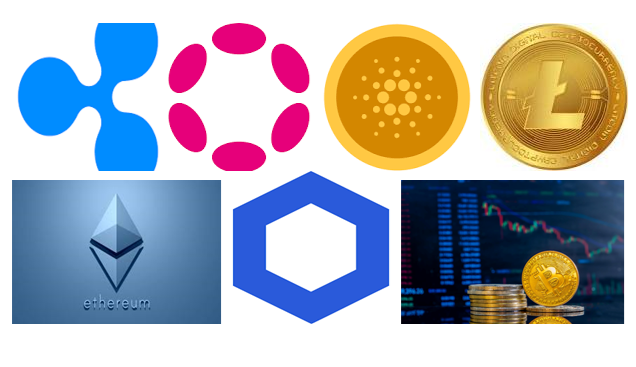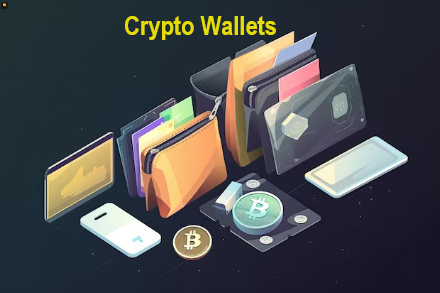Introduction (What Is Cryptocurrency And How It Works)
What Is Cryptocurrency And How It Works, before knowing it in details let us know the basics, Cryptocurrencies, sometimes called crypto-currency or crypto, use cryptography to secure any currency and transaction that exists in digital or virtual form. Cryptocurrencies have no central issuer or regulator, instead using a decentralized system to record transactions and issue new units.
What is cryptocurrency?

Image Credit Freepik
Cryptocurrency refers to digital or virtual currencies secured by cryptography, enabling secure financial transactions. Unlike traditional currencies, cryptocurrencies operate on decentralized networks using blockchain technology, ensuring transparency and security. They’re not regulated by central authorities, relying on cryptographic techniques for secure transactions. These digital assets facilitate peer-to-peer transactions globally, bypassing intermediaries like banks. Cryptocurrencies have gained popularity due to their potential for financial autonomy, borderless transactions, and the innovation brought by blockchain technology to redefine traditional financial systems.
How does cryptocurrency work?
Cryptocurrency operates on a decentralized network using blockchain technology. Here’s a detailed breakdown of how it works:
Decentralization:
Cryptocurrencies are not controlled by any central authority like banks or governments. They operate on a decentralized network of computers called nodes.
Blockchain Technology:

Image Credit Freepik
Transactions are recorded on a public ledger called a blockchain. Each block contains a list of transactions cryptographically linked to the previous one, forming a chain. This process ensures transparency and security.
Transaction Verification:
Miners, using powerful computers, validate transactions by solving complex mathematical puzzles. Once verified, transactions are added to the blockchain, creating a permanent record.
Consensus Mechanism:
Blockchain networks use consensus mechanisms (e.g., Proof of Work, Proof of Stake) to agree on the validity of transactions without a central authority.
Cryptographic Keys:
Users have public and private keys. The public key acts as an address for receiving funds, while the private key, known only to the user, authenticates transactions, ensuring security.
Peer-to-Peer Transactions:
Cryptocurrencies enable direct peer-to-peer transactions globally. Users can send and receive funds without intermediaries, reducing transaction fees and time.
Limited Supply and Mining:
Some cryptocurrencies have a capped supply, fostering scarcity. Mining involves the process of verifying transactions and adding them to the blockchain in return for newly created coins.
Cryptocurrency examples

Bitcoin (BTC):
The first and most well-known cryptocurrency, created by an anonymous person or group known as Satoshi Nakamoto. Bitcoin introduced the concept of blockchain and remains the largest cryptocurrency by market capitalization.
Ethereum (ETH):
Not just a digital currency, but also a platform for decentralized applications (dApps) and smart contracts. Ethereum’s blockchain allows developers to build and deploy smart contracts and dApps.
Ripple (XRP):
Developed primarily for payment systems and remittances, Ripple aims to facilitate fast and cost-effective cross-border transactions between financial institutions.
Litecoin (LTC):
Introduced as the ‘silver to Bitcoin’s gold,’ Litecoin operates on a similar framework to Bitcoin but with faster transaction times and a different hashing algorithm.
Cardano (ADA):
Known for its focus on sustainability, scalability, and interoperability, Cardano aims to provide a more secure and scalable infrastructure for the development of decentralized applications and systems.
Polkadot (DOT):
A protocol that enables different blockchains to transfer messages and value in a trust-free fashion, allowing them to work together seamlessly.
Chainlink (LINK):
A decentralized oracle network that aims to connect smart contracts with real-world data, allowing smart contracts to interact with external information.
How to buy cryptocurrency
Choose a Cryptocurrency Exchange:
Select a reputable cryptocurrency exchange platform. Examples include Coinbase, Binance, Kraken, and others.
Create an Account:
Sign up and create an account on the chosen exchange. Verify your identity, following the platform’s KYC (Know Your Customer) requirements.
Select a Wallet:
Choose a cryptocurrency wallet to store your purchased coins. Wallets can be hardware (physical devices), software (mobile or desktop applications), or online (cloud-based).
Deposit Funds:
Deposit fiat currency (like USD, EUR, etc.) into your exchange account using bank transfers, credit/debit cards, or other supported payment methods.
Choose and Buy Cryptocurrency:
Navigate to the trading section of the exchange and select the cryptocurrency you want to purchase. Enter the amount and complete the transaction.
Transfer Cryptocurrency to Your Wallet:
After purchasing, transfer the bought cryptocurrency from the exchange to your personal wallet for increased security. Use your wallet address to initiate the transfer.
Monitor Your Investment:
Keep track of your investments using the exchange platform or your chosen wallet. Cryptocurrency prices are volatile, so it’s advisable to stay informed.
Consider Security Measures:
Implement security measures such as enabling two-factor authentication (2FA) and using strong passwords to safeguard your accounts and wallet.
Understand Tax Implications:
Depending on your country’s regulations, buying and selling cryptocurrencies may have tax implications. Familiarize yourself with the tax laws regarding cryptocurrency in your region.
Types of Cryptocurrency Wallets:

Hardware Wallets:
Physical devices that store cryptocurrency offline, providing enhanced security. Examples include Ledger Nano S, Ledger Nano X, and Trezor.
Software Wallets:
Applications installed on computers or mobile devices. They can be desktop wallets (e.g., Exodus, Electrum), mobile wallets (e.g., Trust Wallet, Atomic Wallet), or online wallets (e.g., Coinbase Wallet, MyEtherWallet).
Paper Wallets:
Physical printouts or documents containing public and private keys. They’re stored offline and considered secure but can be cumbersome to use for regular transactions.
Steps to Store Cryptocurrency
Choose a Secure Wallet:
Select a wallet that aligns with your preferences for security, accessibility, and the type of cryptocurrency you own.
Set Up the Wallet:
Follow the wallet provider’s instructions to set up the wallet. This usually involves creating an account, generating keys, and securing recovery phrases.
Backup Keys and Phrases:
Backup and securely store private keys, recovery phrases, or seed words provided by the wallet. These are crucial for restoring access if the device is lost or damaged.
Transfer Cryptocurrency:
After acquiring cryptocurrency, transfer it from the exchange or source to your chosen wallet. Use the wallet’s receiving address for the transfer.
Enable Security Features:
Activate security features provided by the wallet, such as two-factor authentication (2FA), PIN codes, or biometric authentication, to enhance security.
Regularly Update and Secure:
Keep the wallet software updated with the latest versions to ensure security patches. Protect the device or access points with strong passwords.
Be Cautious:
Avoid sharing private keys or recovery phrases with anyone. Be vigilant against phishing scams or malware that might compromise the security of your wallet.
What can user buy with cryptocurrency
- Online Retail: Many online retailers accept cryptocurrencies for purchasing electronics, clothing, accessories, and more. Companies like Overstock, Newegg, and Shopify facilitate crypto payments.
- Travel and Accommodation: Travel agencies, airlines, and hotel chains now accept cryptocurrency payments for booking flights, accommodation, and travel-related services.
- Food and Beverages: Some restaurants, cafes, and food delivery services globally accept cryptocurrencies, enabling customers to pay for meals and beverages using digital assets.
- Entertainment: Various entertainment platforms, including gaming websites, streaming services, and digital content providers, accept crypto for subscriptions or in-game purchases.
- Gift Cards and Vouchers: Users can buy gift cards or vouchers for popular retailers using cryptocurrencies, allowing them to shop at those stores.
- Real Estate and Investments: Real estate firms and investment platforms in some regions accept cryptocurrencies for buying property, investment opportunities, or funding projects.
- Charitable Donations: Many non-profit organizations and charities accept cryptocurrency donations, providing a transparent and efficient way to contribute to social causes.
- Luxury Items: Some luxury brands accept cryptocurrency payments for high-end products like jewelry, watches, and art pieces.
Cryptocurrency fraud and cryptocurrency scams
- Phishing Scams: Fraudsters impersonate legitimate websites or individuals, tricking users into revealing their private keys, passwords, or sensitive information, leading to unauthorized access to wallets or exchanges.
- Ponzi Schemes: Fraudulent schemes promise high returns on investment but rely on new investors’ funds to pay returns to earlier investors. Eventually, they collapse, causing financial losses to participants.
- Fake ICOs (Initial Coin Offerings): Scammers create fake ICOs, enticing investors with new tokens at discounted rates or promising high returns. Once funds are collected, scammers disappear without delivering any actual product.
- Exchange Hacks and Exit Scams: Cyberattacks on cryptocurrency exchanges result in theft of users’ funds. Additionally, some exchanges conduct ‘exit scams,’ where they shut down suddenly, absconding with users’ assets.
- Pyramid Schemes: Similar to Ponzi schemes, pyramid schemes rely on recruiting participants who pay to join and earn profits by recruiting others. As the scheme grows, it collapses, leaving late entrants at a loss.
- Malware and Ransomware: Malicious software targets cryptocurrency wallets or exchanges, stealing private keys or locking users’ devices until a ransom is paid in cryptocurrency.
- Social Media Scams: Scammers use social media platforms to promote fake giveaways, impersonate influencers, or offer fraudulent investment opportunities, deceiving users into sending their cryptocurrencies.
Is cryptocurrency safe
- Blockchain Security: Cryptocurrencies operate on blockchain technology, known for its robust security. The decentralized nature and encryption methods make altering transaction data extremely difficult, ensuring transparency and integrity.
- Secure Transactions: Cryptography secures cryptocurrency transactions, making them highly resistant to fraud. Each transaction is cryptographically signed and verified on the blockchain.
- Wallet Security: Cryptocurrency wallets offer varying levels of security. Hardware wallets, considered the most secure, store digital assets offline, reducing vulnerability to cyber threats.
- User Responsibility: Users must safeguard their private keys and follow best security practices. Losing access to private keys could result in permanent loss of funds.
- Regulatory Concerns: The regulatory landscape for cryptocurrencies varies globally. Regulatory uncertainties and potential changes in laws can impact the safety and legality of cryptocurrencies.
- Volatility: Cryptocurrency prices can be highly volatile, leading to investment risks. Fluctuations can result in substantial gains or losses within short periods.
- Scams and Fraud: The crypto space is susceptible to scams, phishing attempts, and fraudulent schemes. Users need to remain vigilant and cautious of potential scams.
Tips to invest in cryptocurrency safely
- Thorough Research: Before investing, understand the cryptocurrency you’re considering. Research its technology, use case, team behind it, and its market potential.
- Diversification: Spread your investments across multiple cryptocurrencies to reduce risk. Avoid putting all your funds into one asset.
- Use Reputable Exchanges: Choose established and reputable cryptocurrency exchanges with strong security measures. Research the exchange’s history, security protocols, and user reviews.
- Secure Wallet: Use a secure cryptocurrency wallet, preferably a hardware wallet, to store your digital assets. Hardware wallets offer enhanced security by keeping your funds offline.
- Stay Informed: Keep up-to-date with crypto news, market trends, and regulatory developments. Stay vigilant against potential scams or fraudulent schemes.
- Risk Management: Only invest what you can afford to lose. Cryptocurrency markets can be highly volatile; never invest more than you’re comfortable with.
- Two-Factor Authentication (2FA): Enable 2FA on your exchange accounts and wallets to add an extra layer of security against unauthorized access.
- Beware of Scams: Be cautious of unsolicited investment opportunities, promises of guaranteed returns, or giveaways. Verify information and avoid falling for fraudulent schemes.
- Long-Term Perspective: Consider a long-term investment approach rather than focusing on short-term price fluctuations. Cryptocurrency markets can be highly volatile, but long-term trends may provide more stability.
- Consult Experts: Consider seeking advice from financial advisors or crypto experts before making investment decisions. Their insights can provide valuable guidance.
We thank you for visiting our post “What Is Cryptocurrency And How It Works”
Read More
Complete Overview of Blockchain Technologies And Challenges 2023
Click Here for similar articles!
Pingback: Decentralized Technologies, Advantage and Disadvantage: A Comprehensive Guide 2024 - Connect And Gain